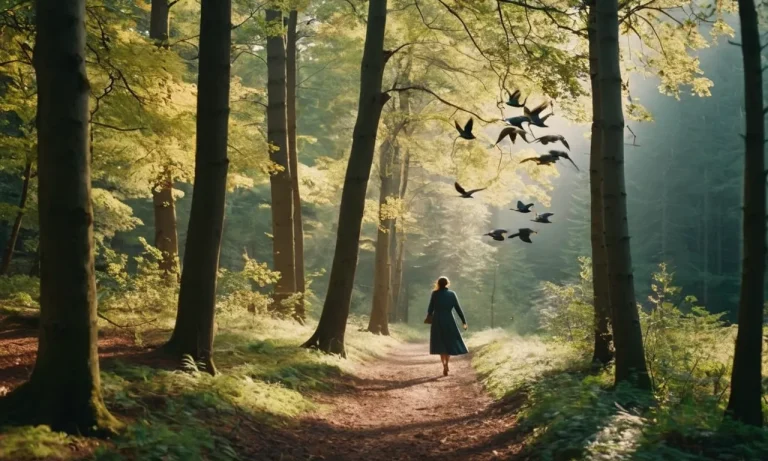The Christmas tree is one of the most iconic and beloved symbols of the holiday season. Its bright lights, colorful decorations, and evergreen boughs fill us with childlike wonder and yuletide spirit.
If you’re short on time, here’s a quick answer to what the Christmas tree symbolizes: The Christmas tree represents eternal life through Jesus Christ as well as God’s unconditional love and gift of salvation. It serves as a reminder of the sacrifice Jesus made for humankind.
In this comprehensive guide, we’ll explore the intriguing spiritual significance behind the tradition of decorating Christmas trees. We’ll look at how the custom originated, the symbolic meaning of different tree parts, spiritual lessons the tree conveys, and even how the lights and ornaments hold religious meaning.
The Origin and History of the Christmas Tree Tradition
The tradition of decorating Christmas trees originated in 16th century Germany, where Christians would bring decorated evergreen trees into their homes. Some records show that as early as the 15th century, fir trees were decorated with apples, nuts, dates, pretzels and paper flowers to symbolize the paradise tree in the garden of Eden.
The first recorded Christmas tree can be traced to 1510 in Latvia and Estonia. By the 17th century, the custom had spread to German families bringing decorated trees into their homes. The trees were often decorated with apples, representing the Garden of Eden, and wafers, symbolizing the Eucharist and redemption.
In the early 19th century, the Christmas tree tradition spread from Germany to other parts of Europe and America. German immigrants were credited with bringing Christmas trees to America, and by the 1840s, the custom had become popular in East Coast cities of the United States.
The first known Christmas tree retail lot in the United States was set up in 1851 in New York by Mark Carr. This made Christmas trees more convenient for Americans to purchase for their home celebrations. And by 1900, one in five American families had a Christmas tree.
Initially, Christmas trees were often hung upside down from the ceiling using chains. Then they would be decorated with fruits, nuts, lighted candles, and egg-shells. Over time, these customs gave way to decorating the trees right-side up, and using glass balls, tinsel, and eventually electric Christmas lights as decorations.
Queen Victoria and her German husband Prince Albert were instrumental in introducing and popularizing the Christmas tree in England in 1841 when they displayed a Christmas tree at Windsor Castle. Due to the couple’s prominence and popularity, Christmas trees became fashionable in England, and later in America.
Through the modern commercialization of Christmas in the late 19th century and 20th centuries, including mass production of Christmas ornaments and retail promotions of Christmas trees, the tradition of Christmas trees became deeply rooted in American and global culture and customs as part of the annual celebration of Christmas.
Today, the Christmas tree tradition has widespread appeal whether among Christians celebrating the birth of Jesus, or among secular cultures who have embraced the Christmas tree as an annual tradition representing beauty, gift-giving and quality time with family and friends.
For many, decorating the Christmas tree marks the beginning of the holiday season.
The Evergreen Tree as a Symbol of Eternal Life
The evergreen tree has long been revered as a powerful symbol of eternal life during the winter solstice and Christmas season. Evergreen trees like spruce, pine, and fir maintain their green needles throughout the winter when other trees lose theirs, showing that life and vigor can persist even in the darkest and coldest months.
Ancient Origins and Beliefs
The concept of evergreens symbolizing eternal life dates back thousands of years. Ancient Egyptians and Romans would decorate their homes with evergreen boughs during the winter solstice, signifying the promise of spring’s return and life’s cyclical renewal.
Many early European cultures such as the Celts also ascribed mystical powers to evergreens and believed they warded off evil spirits.
By the Middle Ages, Germans and Scandinavians began bringing evergreen trees into their homes, with some traditions indicating that the evergreen’s triangular shape symbolized the Holy Trinity. The enduring vitality and emerald color of evergreens like firs and pines came to epitomize Christian beliefs in immortality and the rebirth promised by faith in Jesus Christ.
Their fresh scent and promise of new life offered optimism during dark winter days.
The Christmas Tree Connection
The symbolic ties between evergreens and eternal life intertwined deeply with Christmas traditions across Europe. Records show decorated evergreen trees appearing in German guild halls by the Renaissance era, often adorned with apples representing the Garden of Eden.
By the early 1600s, devout Christians were bringing candlelit evergreens into their homes in December to commemorate Christ’s nativity and resurrection.
The evergreen Christmas tree tradition spread during the Victorian era and took deeper hold during the mid-19th century. In a January 1848 editorial entitled “Evergreens,” the Philadelphia-based Godey’s Lady’s Book said the annual erection of the Christmas tree “carries us back to that blessed night when the Saviour was born into the world…” The magazine helped popularize the joyous home Christmas tree decorating customs so beloved today.
| Year | U.S. Households with Christmas Trees |
|---|---|
| 1989 | 65% |
| 2019 | 76% |
And so evergreen trees and Christmas are linked, with the enduring vitality of firs and pines reflecting the eternal promise at the heart of the holiday season. For millions decking their halls today, the verdant Christmas tree remains an iconic symbol of life prevailing through the darkness – and the spiritual meaning of Christmas truly coming home.
Triangle Shape Representing the Trinity
The triangle shape of the traditional Christmas tree holds deep spiritual symbolism representing the Holy Trinity in Christianity. The Trinity refers to the Father, the Son (Jesus Christ), and the Holy Spirit as three persons united as one God.
This important concept is often depicted visually using a triangle.
The triangle shape of a typical full Christmas tree with a wide base tapering up to a pointed top is a vivid symbolic representation of the Trinity. The three sides of the triangle correspond to the three persons of God, while the single tree signifies their unity.
This evocative symbolism enriches the meaning of the beloved Christmas tree tradition.
Three Important Spiritual Aspects
The triangular Christmas tree as a symbol of the Trinity ingeniously incorporates three key spiritual aspects:
- The base representing God the Father, the creator and source of all being
- The pointed top representing Jesus Christ, believed by Christians to be God incarnate born to redeem humanity
- The inherent life-giving properties of the tree representing the Holy Spirit as the divine breath animating creation
Together, these three aspects poetically convey theological concepts that can seem abstract. Visually and physically manifest in a symbol of great cultural significance, the Trinity is made accessible through the iconic image of the Christmas tree.
Universality Across Denominations
The resonant triangle symbolism spans various Christian denominations embracing the doctrine of the Trinity, including Catholic, Orthodox, and most Protestant faiths. This lends the symbolic Christmas tree broad spiritual relevance for the majority of Christmas celebrants.
Surveys show over 75% of Americans identify as Christian.
So in homes and town squares nationwide, Christmas trees gratefully received and decorated with care carry a layered meaning: one of beauty meeting tradition, seasonal charm, and core Christian beliefs captured in a symbolic triangle.
| Major Christian Denominations Embracing Trinity Doctrine | Approx. Percent of US Christians |
| Catholic | 50% |
| Baptist | 15% |
| Methodist | 6% |
| Lutheran | 4% |
This wide embrace makes the triangular Christmas tree a unity-building spiritual image at a time of peace, joy, and faith-based celebration for vast numbers. That’s an uplifting meaning found in lovely symmetry with decorative glitter and light.
The Tree as a Symbol of the Cross
The Christmas tree has long been viewed as a symbol of Christianity and Jesus Christ. Its green branches pointing heavenwards are seen to represent the promise of eternal life in Christ. The evergreen quality also symbolizes the eternal life we have through faith in Jesus (John 3:16).
In particular, the Christmas tree is linked to the cross on which Jesus died. The vertical trunk reminds us of the upright wooden post of the cross, while the outstretched branches are like the horizontal beam on which Jesus’ arms were stretched out.
Just as the cross was made of wood, so too is the Christmas tree.
This connection between the Christmas tree and Christ’s sacrifice on the cross is meaningful and important. As we decorate the Christmas tree with glittering lights and ordaments, we are reminded of the true meaning of Christmas – the light that Jesus brought into the world to shine in our darkness (John 1:5).
The gifts we place under the tree also symbolize the ultimate gift of salvation made possible by His death for us.
The Tree as a Sign of Hope and Life
The evergreen Christmas tree, with its ability to stay fresh and alive even in winter, has long been a sign of hope and a reminder that life triumphs over death. For ancient cultures like the Egyptians and Romans, evergreens symbolized the promise of the return of spring after winter.
This idea continued in early Christianity, where the Christmas tree represented the eternal life we gain through faith in Christ, who triumphed over sin and death on our behalf. Just as the tree stays green and alive through the winter, Christ offers us hope and life eternal!
The Tree Points Us To Heaven
The ascending branches of a Christmas tree can be seen to represent our reaching towards heaven. The star or angel that crowns the top of the tree symbolizes the heavenly realm, the destination for those who put their faith in Christ.
Decorating the Christmas tree is a reflection of our longing for spiritual reality and connection with the divine. The lighted tree standing in our homes reminds us of the joy, hope and salvation that only faith in Christ can bring.
So when you look at a Christmas tree, remember that its symbolism reflects the true meaning of the season – the light of God coming into a dark world through His son Jesus to give us hope, joy and life eternal!
Lights on the Tree Symbolizing Christ as Light of World
The lights that adorn Christmas trees hold deep spiritual meaning. Each light bulb represents Jesus Christ as the light of the world, spreading hope, peace, and the promise of salvation. The evergreen tree, often seen as a symbol of eternal life, is perfectly complemented by these glimmering lights.
The tradition of putting lights on Christmas trees comes from medieval German lore. Candles were attached to evergreen tree branches, symbolizing the starry sky over the manger where Jesus was born. Over time, electric Christmas lights replaced real candles for safety reasons, but the meaning behind tree illumination remains.
Dispelling Darkness through Christ’s Light
The glowing Christmas tree lights represent how Jesus enters the darkness of a broken world and radiates divine light. Just as the bulbs dazzle eyes that have adjusted to dimness, Christ’s teachings and miracles shine brightly for people lost in the shadows of suffering and sin.
Each individual light bulb cannot illuminate the entire tree by itself. But together, the strands of lights make the evergreen glow brilliantly. This symbolizes how Christians must unite as one body to fully reflect God’s glory.
Believers become lights bearing Christ’s love when they support and strengthen each other.
Guiding Those Who Are Lost
Evergreen trees stay lush even when other vegetation dies in winter. Likewise, the Christmas lights kept burning during cold, dark December nights serve as a sign of enduring hope. The radiance reaches weary travelers struggling through storms, guiding them safely home.
The familiar sight of colorful, flashing bulbs also represents the welcoming, compassionate presence of Jesus. Those lights beckon and embrace even the most vulnerable souls seeking shelter, transforming strangers into friends.
Thus, the glowing tree symbolizes Christ as a faithful guide promising rest, joy, and festive community.
Spreading Cheer and Good News
Illuminated Christmas trees radiate cheer into neighborhoods, similar to how Christ’s teachings uplift spirits with grace and optimism. Settings like town squares, business plazas, and front yards spotlight decked-out firs and pines so their merry lights touch more people.
Like those public evergreens, Christians spread Christmas joy and proclaim salvation in Christ by loving friends and strangers alike. Whether through acts of kindness, worshipful carols, or reflections on Jesus’ birth, believers let the true meaning of the season shine for all to see.
As Christmas lights adorning trees declare glad tidings with their vibrant glow, Christians announce the gospel through their Christ-inspired words and deeds.
Conclusion
The next time you stand before your dazzling Christmas tree and are filled with nostalgic joy, remember that this tradition is soaked in profound spiritual symbolism.
The evergreen tree beautifully embodies Jesus Christ and the gift of eternal life. The lights represent Him lighting our path through darkness. The decorations are like the blessings God showers upon His children.






